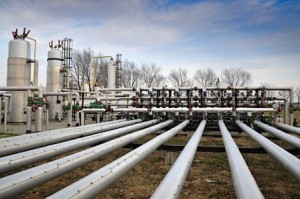 Both West Texas Intermediate and Brent benchmark crudes fell to the lowest in three and four years, respectively, after Saudi Arabia cut its sales price to the United States. A stronger dollar and expectations for a yet another build in US crude oil inventories also weighed on the market. Natural gas rose for a sixth day as cold weather across the eastern US was expected to stoke high heating demand.
Both West Texas Intermediate and Brent benchmark crudes fell to the lowest in three and four years, respectively, after Saudi Arabia cut its sales price to the United States. A stronger dollar and expectations for a yet another build in US crude oil inventories also weighed on the market. Natural gas rose for a sixth day as cold weather across the eastern US was expected to stoke high heating demand.
December US crude fell 1.94% to $77.25 per barrel by 14:46 GMT on the New York Mercantile Exchange, having earlier declined to $75.84 a barrel, the lowest since October 4th, 2014. The contract slid 2.19% on Monday to $78.78 a barrel, its third straight daily retreat. Prices dropped almost 12% last month, the biggest such decline since May 2012.
Meanwhile on the ICE, Brent for settlement in the same month dropped 2.39% to $82.75 per barrel, having earlier fallen to $82.08 a barrel, the weakest since October 2010. The European benchmark crude declined 1.26% on Monday to $84.78 a barrel. Prices plunged 9.3% in October. Brent traded at a premium of $5.50 to its US counterpart, down from Monday’s close at $6.00.
The oil market reinforced its bearish stance after top OPEC producer and exporter Saudi Arabia reduced the premium of Arab Light to U.S. Gulf Coast benchmarks by $0.45 per barrel to the lowest this year. Meanwhile, the kingdom increased its December sales prices, relative to benchmarks, to Asia and Europe.
Although the news was overall mixed, due to the higher price to Asia and Europe, the market’s reaction clearly reflected, and exacerbated, the overall bearish sentiment which has been dominant in the recent weeks. Some analysts saw Saudi Arabia’s move as an intention to fight for US market share by pressuring US shale producers.
Ole Sloth Hansen, an analyst at Saxo Bank A/S in Copenhagen, said for Bloomberg: “Saudi Aramco have once again shown their ability to move the market. The focus for OPEC is really the U.S. market where the biggest source of new supply is coming from.”
OPEC’s 12 member countries will convene in Vienna on November 27th to discuss the group’s production policy. However, OPEC Secretary General Abdullah al-Badri said last week he sees little change to the group’s 2015 output target and that there is no need to panic at the recent slump in prices, reinforcing indications that member countries are in no hurry to cut output.
US crude supplies, output
Prices were also pressured amid speculations that US crude oil inventories probably jumped for a fifth straight week in the seven days through October 31st. Stockpiles are expected to have risen by 1.9 million barrels to 381.6 million, while gasoline and distillate fuel supplies probably declined by 1 million and 2.2 million barrels, respectively.
The EIA reported last Wednesday that US crude oil inventories rose by 2.06 million barrels in the week ended October 24th to 379.7 million, while refineries’ utilization rate slid to 86.6% and US crude oil production surged to 8.970 million barrels per day, the highest in data going back to January 1983.
Industry group the American Petroleum Institute will release its separate data at 21:30 GMT today. However, API’s statistics are deemed less reliable than EIA’s figures as they are based on voluntary information provided by operators of pipelines, refineries and bulk terminals, while the government requires reports be filed with the EIA.
Dollar rallies
A strong dollar continued to weigh on the market. The US dollar rallied to the highest in more than four years against a basket of six major trading partners, boosted by a weaker yen and as the Federal Reserve wrapped up its Quantitative Easing program.
A continuing series of upbeat US economic data also helped push the greenback higher, although the strong figures also brightened demand outlook from the world’s top consumer. The US economy expanded by a better-than-expected 3.5% in the third quarter, while upbeat consumer sentiment reflected the labor marker’s continued improvement.
The US dollar index for settlement in December fell by 0.09% to 87.325 by 14:46 GMT on Tuesday, having ranged between 87.385 and 87.170 during the day. The U.S. currency gauge settled 0.45% higher on Monday at 87.407 after it surged to 87.540, the highest in more than four years.
Market players now awaited the release of this week’s all-important October jobs report by the US Department of Labor, as well as key economic data from Europe, coupled with BoE and ECB’s interest rate decisions.
Natural gas
Natural gas rallied for a sixth day and held firmly above the $4-mark as forecasts warned about sub-freezing temperatures across the Midwest and Northeast.
On the New York Mercantile Exchange, natural gas for delivery in December rose 0.54% to $4.068 per million British thermal units by 14:46 GMT. Prices ranged between $4.106, the highest since October 1st, and $4.029. The contract edged up 4.47% on Monday, the most since mid-June, to $4.046 per mBtu after it ended last week with a 4.73% increase, its biggest weekly gain since February.
According to NatGasWeather.com, natural gas demand in the US over the next seven days will become high, compared to normal, with a slightly colder weather trend for the November 11-17 time span.
The eastern U.S. will enjoy mild weather over the next couple of days, some of which may reach up to 60s and 70s. The central U.S. will be affected by a weak cool front. Later in the week, a quickly moving colder weather system will go through the Midwest and eastern U.S., before a much colder one arrives during the weekend. The Midwest and the Northeast will suffer from near or sub-freezing temperatures, after having warmed up early in the week.
A blast of Arctic air will move into southern Canada on Tuesday and next week will affect the Midwest and Northeast, bringing below normal temperatures. It is uncertain how far this weather system will travel, but it may offset the mild weather in the southern US, should it reach it. Meanwhile, weather in the western U.S. will be warmer than usual, NatGasWeather.com reported, as high pressure dominates. Additional bad weather systems may flow into the eastern U.S. and may result in stronger demand in the northeastern region.
Supplies
The Energy Information Administration reported on Thursday that US natural gas inventories rose by 87 billion cubic feet in the week ended October 24th, sharply exceeding the five-year average increase of 59 bcf and the 45-bcf gain during the comparable period a year ago. Analysts had projected an 85-bcf jump. Nevertheless, the market rallied on weather data.
Total gas held in US storage stood at 3.480 trillion cubic feet, narrowing the deficit to the five-year average to 8.2%, compared to 9.1% a week earlier. Inventories were 7.8% below the 3.774 trillion cubic feet of gas held in storage a year ago.
The EIA is expected to report a build of around 90 bcf this Thursday, which would outstrip the 5-year average gain by 30+ bcf. If confirmed, this would be seen as quite bearish. Support is expected to be drawn by weather data.





